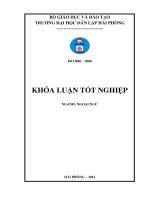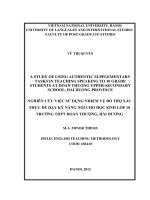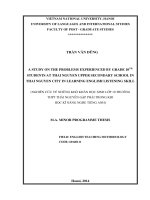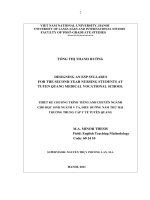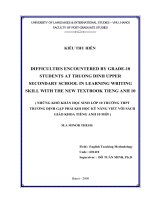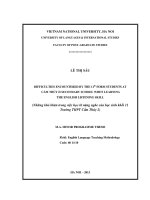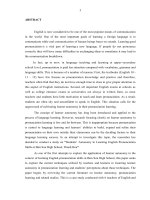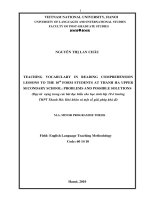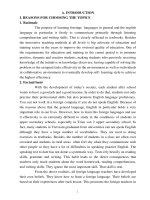SKKN creating the english spaces for students at cua lo upper secondary school
Bạn đang xem bản rút gọn của tài liệu. Xem và tải ngay bản đầy đủ của tài liệu tại đây (1.64 MB, 30 trang )
SỞ GIÁO DỤC VÀ ĐÀO TẠO NGHỆ AN
TRƯỜNG THPT CỬA LÒ
SÁNG KIẾN KINH NGHIỆM
TÊN ĐỀ TÀI:
Creating the English Spaces for students at Cua Lo Upper Secondary School
(Lĩnh vực Tiếng Anh)
Tác giả: Nguyễn Thị Tuấn Anh
Năm 2021
MỤC LỤC
PART A: INTRODUCTION ................................................................................ 1
I. REASONS FOR CHOOSING THE TOPIC ..................................................... 1
II. AIM, OBJECTIVE, METHOD, SUBJECT AND RANGE OF THE STUDY...... 2
1. Aim of the study: ............................................................................................... 2
2. Objective of the Study:...................................................................................... 2
3. Method of the Study .......................................................................................... 2
4. Range of the Study: ........................................................................................... 2
5. Novelty of the Study: ........................................................................................ 2
PART B: CONTENT ............................................................................................ 3
I. THEORETICAL BASIS OF THE TOPIC: ....................................................... 3
II. PRACTICAL BASIS OF THE TOPIC ............................................................ 3
III.PRACTICAL APPLICATION IN CREATING THE ENGLISH SPACES
FOR STUDENTS .................................................................................................. 4
1. The news space.................................................................................................. 4
2. The movies space: ............................................................................................. 9
3. The conversation space ................................................................................... 14
4. The connect space ........................................................................................... 17
5. Music space: .................................................................................................... 20
PART C: CONCLUSION ................................................................................... 23
I. RESULTS OF THE EXPERIENCE APPLICATION .................................... 23
II. SUMMARY: .................................................................................................. 25
III. PROPOSALS: ............................................................................................... 25
CUALO UPPER- SECONDARY SCHOOL ...................................................... 26
ONE-MINUTE SURVEY FOR STUDENTS .................................................... 26
CUALO UPPER- SECONDARY SCHOOL ...................................................... 27
ONE-MINUTE SURVEY FOR TEACHERS .................................................... 27
REFERENCE BOOKS ....................................................................................... 28
PART A: INTRODUCTION
I. REASONS FOR CHOOSING THE TOPIC
In the context of teaching and learning foreign languages, especially
English in Vietnam today, how to build up and develop the environment in
which learners can use the language naturally and actively is getting more and
more essential and this is also the issue that the leaders, teachers, students and
the community have paid a lot of attention to. Through real situations created,
learners not merely have chances to practice their language skills and apply what
they have learnt to the ones in real life but also become more and more selfconfident as well as interested in learning and using the language, which plays
an indispensable part in helping learners make good progress. In addition, the
active learning environment through real situations also improve the quality of
teaching and learning foreign languages in general and English in particular.
Thus, the educational leaders from the Ministry of Education and Training as
well as Nghe An Department of Education and Training has brought in a lot of
guidelines to encourage the educational organizations and schools to create the
environment outside classrooms for students to learn and use English.
In an attempt to meet the demand of the leaders and the need of improving
the quality of teaching and learning English, my colleagues and I have organized
a great many activities called English spaces in the form of small clubs in which
students can gain knowledge of various aspects in English through real
situations. Through the process of implementing these activities, students at my
school are getting more and more interested and active in learning English,
which really helps to raise students’ awareness and attitude towards English as a
core subject.
For the reasons above, I have chosen the topic: “Creating the English
Spaces for students at Cua Lo Upper Secondary School”. I would like to share
a few experiences of creating English learning environment to engage the
students’ passion for English so that it is no longer a difficult and boring subject
in classes.
The topic consists of three main parts:
Part A: Introduction which includes the Reasons for Choosing the Topic,
the Aim of the Study, the Objective of the Study, the Method of the Study, the
Range of the Study, and the Novelty of the Study.
Part B: Contents with the Theoretical Basis of the Topic, the Practical Basis of
the Topic and the Practical Application in Creating the English Spaces for
students.
1
Part C: Conclusion including the Results of the Experience Application,
the Requests and the Proposals.
II. AIM, OBJECTIVE, METHOD, SUBJECT AND RANGE OF THE STUDY
1. Aim of the study:
The topic was studied and applied with a view to enhancing the
competence to use English for students at upper secondary schools. It is also
served as a source of materials that help teachers of English in their teaching.
2. Objective of the Study:
The writer’s experiences shown in this study may provide English
teachers with a source of materials to create the English spaces for students. In
addition, students can also use the activities illustrated in this study for their selfstudy in practicing English.
3. Method of the Study
- Studying the materials about giving the English spaces in reference
books.
- Analyzing and drawing experiences from the process of carrying out.
- Studying the sources of documents relating to the content of the process
of creating the English spaces for students such as news, movies, kinds of
music,….
- Applying in the real working to self evaluate.
4. Range of the Study:
The teachers from English group and the students who have attended the
English spaces at Cualo upper secondary school.
5. Novelty of the Study:
Many studies have mentioned improving the students’ competence for
using English up to now. However, they have discussed general activities or
activities for teaching specific skills inside classrooms.
In this study, the writer have tried to show the activities to create the
English spaces for students outside their classrooms with the aim to help them
be more active and confident in learning English as well as get used to using
English in daily life.
2
PART B: CONTENT
I. THEORETICAL BASIS OF THE TOPIC:
The leaders are really concerned about teaching and learning English and
have enacted a lot of regulations as well as suggested methods that helps to
improve the quality of teaching and learning English. On the 30th September,
2008, the Prime Minister signed a decision No 1400/ QĐ-TTg, approving of the
Scheme “Teaching and learning foreign languages in the national education
system” (also known as Foreign Languages Scheme 2020). The objective of the
Scheme is carrying out the overall renovation of teaching and learning foreign
languages in the education system. Besides, On the 8th April, 2011, the head of
the Ministry of Education and Training signed a decision No 1400/ QĐBGD&ĐT establishing a committee to manage the Scheme “Teaching and
learning foreign languages in the national education system for the period of
2008-2020”. These policies have laid the foundation for the overall changes in
teaching and learning English in the education system. Additionally, the
Ministry of Education and Training issued a statement No 4536/ BGDĐTGDCTHSSV dated October 4th, 2019 to guide the implementation of the English
learning movement and the development of the environment for learning and
using English. Thus, Nghe An Department of Education and Training released a
statement that required the schools to accelerate the development of the
environment for learning and using English since the academic year 2019-2020.
Obviously, this has become one of the main duties of English teachers at
schools.
II. PRACTICAL BASIS OF THE TOPIC
Although students are taught the language skills including listening,
speaking, reading and writing and grammar lessons at school, they don’t have
chance to practice the language because the time is limited. Moreover, the final
examination just focus on the written test with a view to checking students’
knowledge of English grammar. Most students try to learn the grammar rules to
get high marks in the tests. They have no opportunity to use English. In classes,
they sometimes hesitate to communicate in English because the structures and
situations given in the textbooks are somehow inflexible and not natural enough
like in daily communication. Creating the environment for students to use
English with real situations helps to solve these problems and makes students
nurture their passion for English. They also have chance to express their English
competence. On the other hand, nowadays, English as a means of
communication and entertainment is no longer strange to students, especially to
3
those who live in big cities. Children are sent to English centres to learn with
native teachers at a very young age. Besides, good living conditions provide
students with lots of modern facilities that help them get familiar with English
day by day through electronic equipment connected to the Internet. The sources
of news, entertainment, academic knowledge or requirements from work in
English have made it become a crucial part of a modern life. Students, hence,
are eager to learn English in a different way outside classrooms. Simultaneously,
they have also shown their excellence and good competence in understanding
the Western culture and related knowledge in English.
III.PRACTICAL APPLICATION IN CREATING THE ENGLISH
SPACES FOR STUDENTS
The plan had been made and discussed by the English teachers at school
even before the start of the school year to make sure that everything was well
prepared. First of all, we chose a group of the organizers for each space. The
organizers were responsible for collecting information, prepared the contents
and called for the participants as well as arranged the timetable. Below are the
way each space proceeds.
1. The news space
1.1. Goal: - To help the participants ( students) to practice skills of reading
newspapers, getting information and discussing in English.
1.2. Language level needed: Elementary at least ( it’s up to knowledge and
personal ability of language as well as documents selected)
1.3. Prepared materials: English newspapers and cards of suggested questions.
1.4. The content and method of organizing:
Some English newspapers are given in the school English room so that
participants can choose, read and discuss.
The organizers should fix the theme for each time of performing. All
participants will be given newspapers or pieces of news prepared by organizers.
The participants will also be given a card with suggested questions on, which
direct the information they must focus on. At the end of the period the
organizers ask all the participants to gather so that they can present the news
they have read which have been discussed in groups.
1.5. The rules of discussing: No discussed ideas are true or false. The most
important thing is just sharing the ideas and opinions.
1.6. A sample of the news space: Theme: Celebrity
+ Introduction: The organizers show some famous people such as “ Tom
Hanks, David Beckham, Bill Gates, etc…with a clear explanation : “ These
4
people are very famous all over the world. They are called celebrities”. This
makes the participants clearer about the theme.
+ Procedure:
After introducing, the organizers may ask the participants to name some
other celebrities that they know to make sure that all the participants understand
the theme clearly.
● Group work arrangement:
The organizers then divide the participants into groups. Five articles with
different contents related to the theme are given out. Each article is printed on 4
sheets of paper put in a box. Therefore we need 5 boxes with orders from 1 to 5.
Remember that the content of the article is on one side of the sheet of paper and
the suggested questions are given on the other side.
Next, the organizers have participants choose articles from 5 boxes. Thus, the
participants are divided into 5 groups of four. It mean that those who have
chosen the same article from one box will be in the same group.
● Discussion:
Members of groups read articles within 10 or 15 minutes. Having read
articles they discuss and share the contents of the articles with the others in
groups
● Exchanging information among the groups
After each group have finished discussing, the organizers ask the groups
to gather according the former positions. Next, the representatives from groups
present the content of the articles they have read as well as their ideas, opinions
about the articles.
Having heard the preparation of each group, the members from other group ask
questions about the articles. These questions should be answered or explained
clearly by members who have read and understood the articles. May be
organizers help them if necessary with the aim to make everyone gain as much
information as possible.
● Wrapping the program
The participants express their feelings, experiences they have obtained
from the program. The organizers make some remarks on the performance and
encourage the participants with compliments or some presents.
1.7. Some pictures of the prepared materials and the activities oganized:
5
GUESSING GAME
THE NEWS SPACE
Topic: Celebrities
The pictures of different celebrities
will be shown on the screen.
Raise your hand if you know
his (her) name and tell us about it.
“”NEWSPAPERS READING
TASK””
Table Of Contents
Our Teaching
Here you could describe
01. Method
Our Academic
Here you could describe
02. Areas
the topic of the section
the topic of the section
Enrollment
Here you could describe
04. Process
Our Teachers
03.
The leader of each
team will pick a
random newspaper.
Here you could describe
the topic of the section
the topic of the section
Each team will be
given a Summary
form.
You will read the
newspaper and
fill in the form
in 5 minutes.
The representative of
each team will show
everyone the main
content of the
newspaper based on
the Summary form.
Order of presentations
David
Beckham
Ariana
Grande
Coco
Chanel
IU
Tom
Cruise
1
2
3
4
5
Comments
from the
teachers
6
7
8
2. The movies space:
2.1. Goal: To help the participants to practice skill of listening and discussing
through watching movies.
2.2. Prepared materials: English films, cards of vocabulary and suggested
questions.
2.3. The content and method of organizing:
Before showing films the organizers have the participants discuss the
words/ idioms which will appear in the films. Next, the organizers guide the
participants the way to understand these words especially the idioms which are
particular in native culture. During watching the films, participants can use
guiding questions to focus on the main content of the film. This also helps them
to discuss easily and effectively .
2.4. A sample of movies space
The film Harry Potter
* Warm-up: The participants exchange some information in English so
that they can know each other more clearly. As a result, the English atmosphere
becomes warmer and more active.
* Introduction:
One member of the organizers asks the participants some questions such
as:
- “ Have you ever watch the Harry Potter?”
- “ When did you see it?”
- “ What was it about?”
- “Do you like it ? Why? Why not?”
…………….
May be many of the participants have seen this film before but they surely
saw it in Vietnamese.
The organizers show the main characters of the film and elicit the answers with
some questions: “ What are their names?”; “ What do you know about them?”
………………..
The organizers state that the participants are going to see the film again
but the difference is that they will watch in English not in Vietnamese.
* Getting the meaning of the words/ idioms in the film
The organizers should focus on how important it is to grasp some
vocabulary, especially the vocabulary of cultural factors or communicative
situations. This makes the participants understand the content of the film easily.
9
The organizers have prepared some cards with about 10 words/ idioms/
phrases which will appear in the shown part of the film. Each word or phrase
should be printed on two cards.
Each of the participants has to choose a card and read the content of the
card within a minute . Next, the participants talk to each other about the words/
phrases/ idioms they have got from the cards. Surely that they shouldn’t
exchange their cards in any way.
When the time is up, the organizers ask the participants back to their seats to
hear the meaning of the words given on their cards. The organizers should
introduce word by word ( or phrase/ idiom) so that all the participants can
understand them clearly.
Example: “ everywhere else is full?” ; “ scar”; “ spell” ; “ oculus”
“ we’ll take the lot”……….. etc….
* Watching the main part of the film
The organizers show the main content of the film which relates to the
questions given on the cards and the participants write down the main ideas of
the film.
* Discussing the shown part of the film
After the film finishes, the organizers divide the participants into 4
groups.
The questions given on the cards will be on the screen so that the
participants can see and discuss in groups within 4 minutes. At this time the
organizers observe and help the groups if necessary.
Next, the representatives from 4 groups present their ideas basing on the
questions within 5 minutes.
Having observed and heard the presentation of 4 groups, the organizers
give fed back.
* Wrapping the program
The organizers deliver each of the participants a piece of paper and ask
them to write down their feelings, ideas, opinions about the film or the program
within 5 minutes. The participants should be encouraged to write as much as
possible without limit of words or content.
Finally, the representative of the organizers gives some remarks on the activities
have been done during the program.
2.5. Some pictures of the prepared materials and the activities oganized:
10
It’s time for you to
receive your flashcards
and learn by heart
all of them
Now, it’s time for you
to enjoy the movie!
FIND THESE WORDS
WORD SEARCH PUZZLE
Not at all
Flavor
Spell
Peppermint
Scar
I’m all set
Wizard
Spinach
Toad
Holy cricket
Robe
By the way
Trolley
Activities
02
Goals
Despite being red,
Mars is actually a
cold place
01
03
I
A
M
A
L
L
S
E
T
P
R
E
E
N
T
N
A
W
H
S
T
E
K
C
I
R
C
Y
L
O
H
O
Q
S
P
E
L
L
E
T
D
Y
Z
T
P
R
T
T
Y
B
L
X
C
A
N
S
L
E
I
A
O
D
N
A
E
S
Y
O
G
E
R
R
A
P
W
S
C
A
R
T
R
H
S
T
F
L
A
V
O
R
R
I
T
A
D
A
E
R
A
T
H
N
L
C
Y
B
U
S
T
N
M
L
Z
T
S
P
Y
E
T
J
O
K
E
D
F
C
A
A
P
I
H
F
P
A
W
Y
E
L
L
O
R
T
H
V
E
C
W
N
M
Y
V
A
P
E
P
P
E
R
M
I
N
T
I
H
T
D
A
Y
Y
THE CURRICULUM
OUR TEACHING METHOD
Jupiter is a gas giant and
the biggest planet in our
Solar System
B
Dance
Despite being red, Mars
is actually a cold place
Feedback
and
Evaluation
Music
Venus has a beautiful
name, but it’s terribly hot
Saturn is a gas giant,
composed of
hydrogen and helium
Theatre
Saturn is composed of
hydrogen and helium
11
01
02
03
12
13
3. The conversation space
3.1. Goal: To develop skills of communication such as listening, speaking and
conversing
3.2. The prepared materials: Some cards with suggestions and questions on
3.3. The content and method of organizing
The organizers have decided the theme of the conversation and the cards
containing some questions and vocabulary or structures which relate to any
matter of the general theme.
Coming in each of the participants will be given a card with some
suggestion on to discuss with the others. Next, they will be divided into small
groups ( about 4 or 5 members in a group). The participants now discuss in
groups with different matters of each member. Finally, the organizers ask the
groups to talk about their discussed matters. When a group presents their matter
the others pay attention and make some questions about that matter so that all
the participants have a chance to share ideas, opinions or discuss the conversed
theme.
3.4. A sample of conversation space
* Warm- up:
The participants sit around tables in groups of four. Each of the organizers
is responsible for observing, controlling and managing a group.
After stabilizing the groups the manager of each group has their members
greet, ask each other some questions in English within 3 minutes so that they
know each other more clearly. Of course, this also helps creating a warmer,
more open atmosphere.
* Procedure:
-The organizers state the theme of the conversation “ Daily life”
In order to perform this conversation there must be 16 cards wellprepared for two turns
+ The first turn; each card asks for personal information to be discussed.
For example: Name/ Class/ Reasons for joining/ Hobbies/ Interests/ Future plan
etc,…
+ The second turn: Each card asks for personal ideas about everything in
daily life to be discussed. For example: Your feeling about daily life in your
neighborhood/ Your opinions about style of young people nowadays/ Your ideas
about the differences between the children and their parents/ Your impression on
the landscapes in our hometown…..etc…
14
- The members of the organizers are in charge of showing the cards on the
tables in turn so that the participants can converse with each other about the
matters relating “daily life”.
- Remember that, each turn is about 2 minutes to make sure all the
participants have chances to talk about their requested contents.
- After presentation of each member the others may ask some questions to
get more information about the mentioned matters.
* Wrapping the program
The members of the organizers ask the participant of the groups they are
in charge of managing to talk about their experiences, knowledge or memorable
things from the conversation. Finally, the representative of the organizers
summarize all the ideas and conclude the program.
3.5. Some pictures of the prepared materials and the activities oganized:
15
16
4. The connect space
4.1. Goals: To develop the communicative skill through speaking and listening
activities which help to improve the connection and interaction among the
participants.
4.2. Prepared materials: The cue -cards
4.3. The content and method of organizing
Each of the participants is given a card of questions to prepare. They stand
in two queues face to face. Participants talk to the opposite members within 5
minutes. The talks may be about personal information or common interests/
hobby etc….After talking to a partner the participants move on the right or left
to find another partner to make sure all the participants have new partners.
Remember that the themes should be popular with students such as music,
sports, entertainment or their impression on school, friends, teachers…
However, the organizers may suggest some themes which are necessary to
students such as future jobs, daily activities, socialization, holidays, shopping
online, how to keep fit..etc.
After the participants finish interacting, the guider may ask some of them
to report the information which has been discussed. The guider must note down
to state the person who should be praised with the most information about the
partners.
Note: In a program there must be the only theme, therefore the organizers
should prepare questions in details on the cards. This will make participants can
interact easily during the program.
4.4. A sample of connect space
* Warm- up:
The participants greet each other and ask some questions about anything
they are interested in within 3 minutes with the aim to make the atmosphere be
cozier and more exciting.
* Procedure:
- The representative of the organizers introduces the theme of the
program of connect space “ Your health”
- The organizers deliver each participant a card which contains a question.
Next, the organizers explain the way of organizing.
- The participants are arranged into two rounds ( 10 members for each
round). The members in two round are face to face. After they exchange
personal information the participants start interacting about the questions given
on the cards.
17
These questions may be :
+ “ What do you think is the best way of keeping fit and healthy?”
+ “ What kind of sports or gymnastics do you like best and why?”/
+ “ What is your opinion about a healthy diet?”
+ “ Which habits are good / bad for our health?”
+ “ List 5 benefits of a having a healthy and fit body?”
……………………
- The participants continue interacting with each other from the first round
to the second one in the same way. The members of the organizers observe and
help the participants if necessary.
* Wrapping program
After the 35 minute process of interacting, the organizers should sign to
sop and have some of the participants report all the questions they have asked as
well as they have been asked.
The organizers choose the person who remembers most information of
their partners to be given the presents from the program. Finally, the participants
evaluate the program they have just joined and the representative of the
organizers conclude the program.
4.5. Some pictures of the prepared materials and the activities oganized:
18
19
5. Music space:
5.1. Goals: To help the participants to improve their skills of listening and
understanding vocabulary/ idioms through songs.
5.2. Materials needed: Some musical clips, video of songs which are popular
with the youth. Cards of vocabulary/ idioms and guiding questions.
5.3. The content and method of organizing
Before listening to songs, the participants discuss some words/ idioms
which will appear in the songs. They should be stimulated to try to practice
discussing as much as possible. This will make them listen and understand the
words of songs more easily.
5.4. A sample of music space
* Warm -up: Participants stand around and exchange some information
within 3 minutes so that they become closer and the atmosphere get warmer.
* Procedure:
- The representative of the organizers introduce the song “ Heal the
World”.
- The organizers ask some questions :
+ “ Who has ever hear this song before?”
+“ Whose this song is it?”
+“ When was it written?”
+ “ Who is the best singer singing this song?”
May be some participants have ever heard or know this song and these
participants will help the others during listening to it.
- Getting the meaning of the words/ idioms in the songs
Before listening the participants are given some cards with some words/
sentences/ phrases extracted from the song “ Heal the World” such as
+ “ You’ll feel there no hurt or sorrow”
+ “ Care enough for the living”
+ “ make a little space”
+ “ it only cares of joyful giving”
+ “ Wound this earth, crucify its soul?”
+ “ swords”
+” plowshares”
+ “…………………………………….”
The participants have about 3 minutes to read and discuss with each other
the words/ sentences/ phrases given on their cards.
20
Having discussed the participants will listen to the song. The organizers
should pause the song at the position where words/ phrases have been extracted
and ask the participants who had the cards with these words/ phrases. The
organizers have them try to understand these words/ phrases and they can
explain the meaning especially in the song.
After hearing the song, the participants discuss in group. They will help
each other to understand the entire song. Next, the representatives from the
groups report what they have discussed and understood about the song.
The organizers pay attention to their presentation and then give feed back
so that all participants understand the song “ Heal the World” clearly and the
message that everyone should be responsible for making the world- the common
home always peaceful, safe to all.
* Wrapping the program
The participants are simulated to express their feelings, opinions about the
program as much as possible.
One of the organizers points out the active results of the program and
some shortcomings which should be considered.
Finally all members of the program sing the song “ Heal the World”.
5.5. Some pictures of the prepared materials and the activities oganized:
21
22
PART C: CONCLUSION
I. RESULTS OF THE EXPERIENCE APPLICATION
“Creating the English spaces for students” has been applied at our school
in school years 2019-2020 and 2020-2021. It has been proved to work well with
some considerable results.
Firstly, the teachers of English group and students have mixed with
English communicative atmosphere daily. They can approach authentic
materials and improve speaking skills as well as cultural knowledge of Englishspeaking countries . Therefore, they can use English more naturally.
Secondly, students are stimulated to use English whenever they have
chances.
Besides, a community of learning English at our school is set up through
connecting the teachers with students of different levels.
In addition, students have improved their listening and speaking English
which has made them more confident and more interested in English lessons at
classes.
Below are the results of two surveys we have carried out with the same
students before and after applying this experience.
* The survey before applying the experience
Class
Surveyed
students
Interested in
English lessons
Afraid of
English
lessons
Confident to
speak
English
Mind
speaking
English
11A2
25
7
18
5
20
11D4
25
12
13
9
16
12T2
25
10
15
11
14
12D3
25
11
14
10
15
* The survey after applying the experience
Class
Surveyed
students
Interested in
English lessons
Afraid of
English
lessons
Confident to
speak
English
Mind
speaking
English
11A2
25
22
4
19
6
11D4
25
20
5
18
7
12T2
25
10
5
17
8
12D3
25
21
4
18
7
It can be seen from the two tables above that the number of students being
interested in English and confident to speak English has increased as the result
23
